Jack Horner can dispense with his mad scientist franken-chickenosaurus machinations. We already have plenty of fine and dandy carcass processing theropods in all corners of the world - land and sea - right now, thank you. In my last post, Allosaurus - More of a Vulture Than a Falcon, I described a remarkable convergence in several lineages of carcass rendering birds that use a macabre feeding technique I have dubbed "choanal grinding". This feeding method in turn inspired a theorized feeding technique in Allosaurus that I outlined and referred to as the "bonesaw shimmy" - the shimmy being a dance based upon rapid alternate movements of the shoulder, outlawed due to it's overtly sexual nature in the 1920's . This "bonesaw shimmy" in turn may yield implications for other theropods to varying degrees I suggested.
In this post I want to expose a known anatomical characteristic linking past and present carcass rendering theropods (forgive me for using the term theropod loosely as such, for me it implies both extant aves and Mesozoic theropods/paraves/true avialians unless otherwise specified) . This characteristic - which is so painfully obvious it has hid in plain sight - has the potential to offer much utility in inferring likely feeding behavior and technique in both Mesozoic and Cenozoic theropods.
But as I am one with a little bit of a penchant for theatrics, I do not want to introduce that overlooked anatomical characteristic just yet but instead let us first spend some time with the bearded vulture aka the Lammergeier (Gypaetus barbatus).
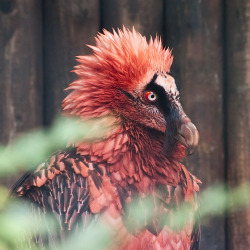 |
| Lammergeir. credit unknown but too cool not to share |
Impressive, no? And for some nice footage of bearded vultures at a feeding station. If you squint your eyes a bit, not too hard to imagine dromaeosaurids or unenlagines in the clip below.
If you are still smitten with the regal beauty of these birds here is a nice close up video (the first pic of this post is a screen grab from it).
Now maybe you have never spent that much time up close and personal with these birds until now. They are astonishing - and that strong dinosaurian vibe you get off their appearance is not a mistake. Whether or not you keyed into the anatomical congruence that unites 230 million years of carcass rendering theropods yet is ok - you probably subconsciously sense it.
What I am referring to - the uniting anatomical peculiarity - is the supraorbital ridge or brow ridge if you will present in this and many other carcass rendering birds and Mesozoic theropods. Relatively obscured in the lammergeier due to feathers it is more noticeable in the lappet-faced vulture below giving it that distinctive "evil" glare. Not coincidentally (as I will discuss) the lappet-faced vulture is a large vulture with a penchant for the particularly tough and gristly parts of carcasses as well as a noted predator.
 |
| lappet-faced vulture.ccsharealike2.0. credit KCZoofan |
 |
| CA condor skull. credit Kai Schreiber. CCsharealike2.0 |
 |
| Southern Giant Petrel skull. credit OVAM. CCbylicense |
 |
| note the "eagle eye" brow ridge. CC3.0 credit Graham Curran |
 |
| eagle skull. credit Kai Schreiber. CCsharealike2.0 |
The tops of Mesozoic theropod heads are also adorned with an array of crests, eye ridges, lacrimal horns, knobbly protuberances and often times fairly thick bone deposits. In fact you can take a fairly base model crest such as you see on Coelophysis or Allosaurus and the vast majority of predatory theropod heads are but slight deviations.
| Coelophysis bauri |
 |
| credit Witmer's Lab |
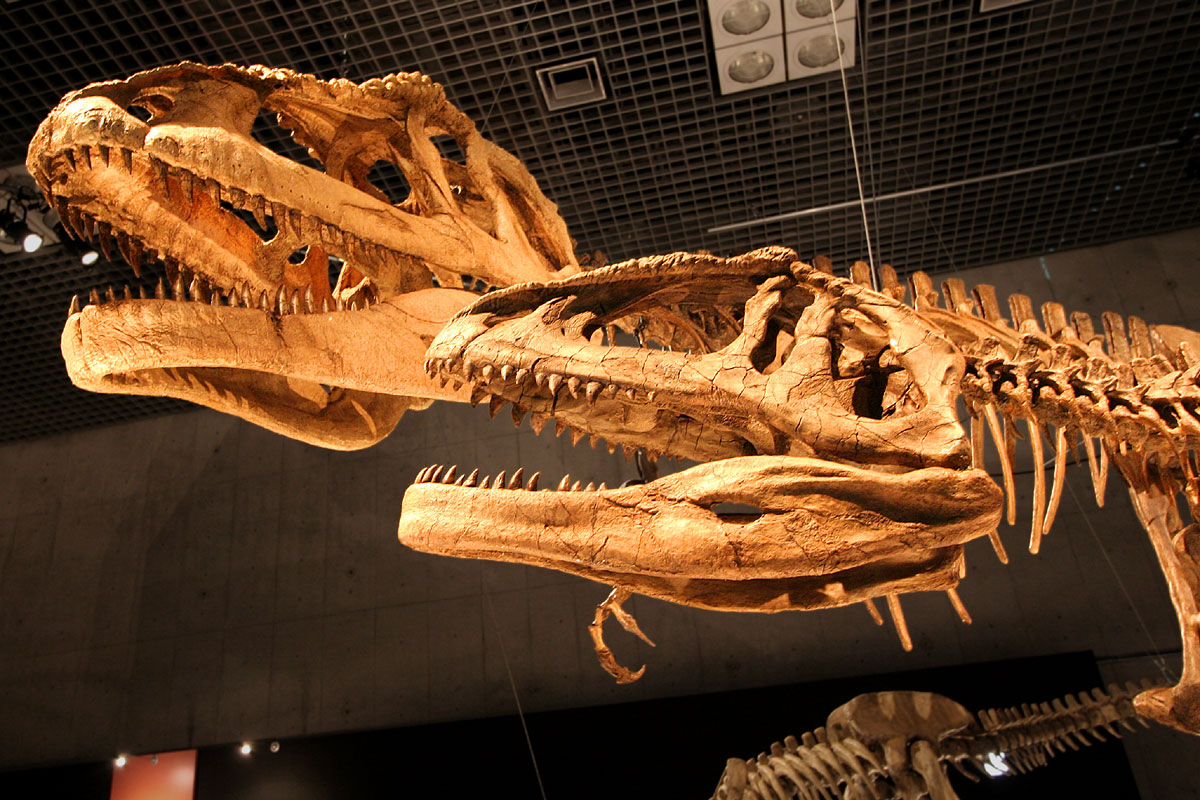 |
| Mapusasaurus roseae showing the thick lacrimal/nasal crests along top of skull. credit Kabachi CC2.0 |
Instead I am going to offer an alternative explanation: These structures - although potentially co-opted for display, combat, sun shielding - had their impetus not for any one of these reasons but were generated for biomechanical reasons.
The biomechanical origin for these structures lays in absorbing stresses and strains from strenuous feeding activities.
Again, let me get a little nuanced here because I think nuance is sometimes lacking in these types of discussions and people get hemmed into either/or debates. For sure, in critters like Dilophosaurus or Monolophosaurus these structures are custom built as display structures. But what I am suggesting is that if a structure is in fact a display structure - it is usually obvious. And in the vast majority of theropods the head gear is a lot more conservative and primarily serves a mechanical function.
If we look at the theropod head it is a compromise between strength and lightness of build. The head had to be strong enough to interact and sustain integrity through vigorous encounters with prey/rivals. But it also had to be as light as possible to facilitate the rapid neck driven feeding mechanisms that were fairly ubiquitous across the group. The lacrimal horns, ridges, rugosities etc etc. serve as "energy dumps" where the stress and strains encountered across the mouth are transferred up and away and "dumped" into the thick deposits of bone and pneumatic cavities at the top of the skull. A study of stress and strain distribution in the skull of Allosaurus pretty much spells it all out.
Note how in the above visual (from Rayfield et al. looking at forces in the skull of Allosaurus) that compressive forces marked "yellow" are being concentrated towards the lacrimal, nasal, frontal bones up those struts of bone away from the tooth row. Most telling is the pic on the bottom right where the course of the compressive forces appears to be literally tracing the crest line on the top of the skull of the allosaurus. In fact if you take a second to look at the architecture of a theropod skull holistically - it appears biomechanically designed to move stress/strain away from the tooth row towards the top of the head. This makes sense for a predator that needs to bite stuff and does not want to suffer mechanical failure of its teeth/jaw. Excessive forces can be shunted away towards thick crests/nasal bosses/brow ridges etc etc. Not only that but it minimizes the deposition of heavy thick bone throughout the whole skull - which would add cumbersome weight - and maximizes the animal's ability to move its head quickly and efficiently.
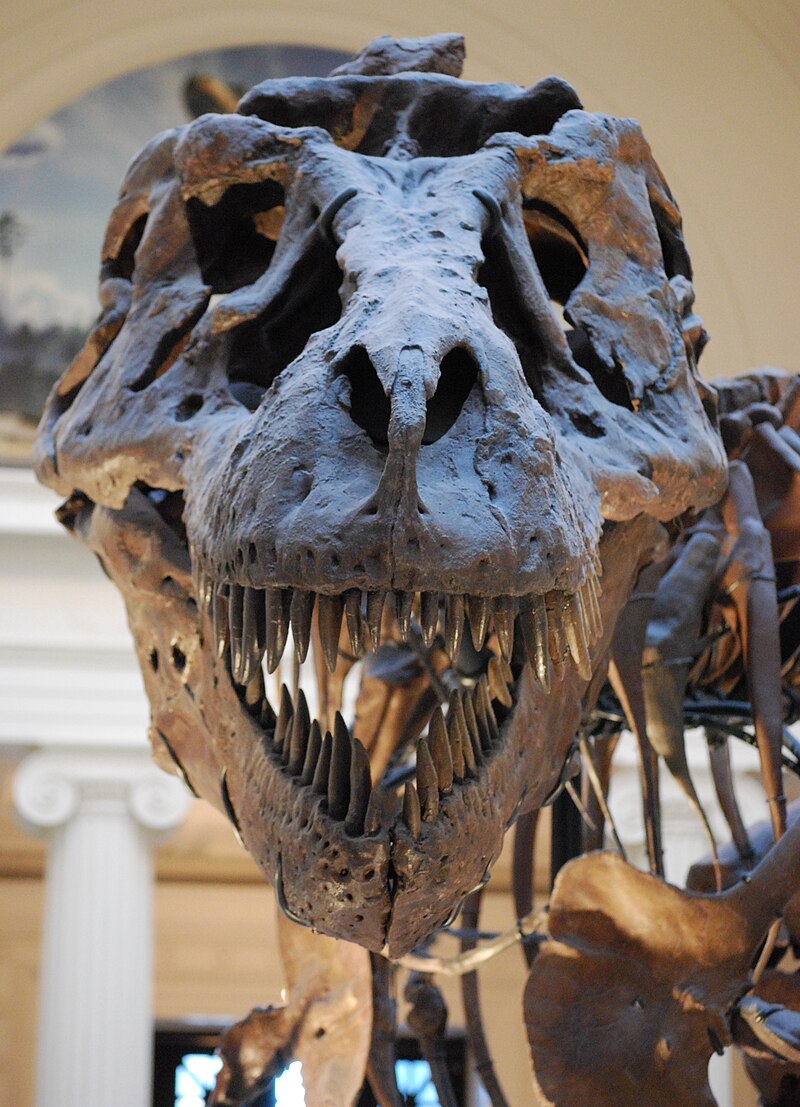 |
| credit Scott Robert AnselmoCC3.0. Trex |
And you can see this thickening of the top of skull to full effect in the pic here of T-rex. A mechanical design begetting thick theropod crests. If we accept the maxim that form follows function the mechanical advantages of such a design elegantly explain the long tenure of the design.
Why has no one has approached the issue of why certain theropods have converged on such thick lacrimal/nasal/orbital ridges before is a good question. Maybe we just are taken in by the cool factor of it - they do add a bit of style and flair to their look. But, as I always tell my traffic school students, things have a way of hiding in plain sight.
Ok, so if my hypothesis has merit - that these structures serve as "dumps" for excessive forces incurred during vigorous feeding bouts - then a good test would be to see if said structures are diminished or absent in theropods that feed on small prey, fish, or have explored a more omnivorous or herbivorous lifestyle.
 |
| Ornitholestes hermanni. Osborn 1903. AMNH 619, holotype from Carpenter et al. 2005 |
 |
| Masiakasaurus knopfleri. |
 |
| Suchomimus.creditAStrangerin theAlps.CC2.0 |
Suchomimus tenerensis. Usually interpreted as a fish eater, although an opportunistic small/medium game predator is likely given the dino/pterosaur consumption shown in close relatives. And don't be fooled by the notion of "mere fish eater" either. Some of these fish on the menu were huge with heavy, ganoid scales. So in spinosaurs we see a single crest with some pretty thick looking bone as well as some nice ridges around the eyes. So although not as heavily crenulated/crested as carcharodontosaurids. allosaurids, tyrannosaurids and other large game hunting theropods there is still some amount of crest/ridge action consistent with the stresses likely incurred from a diet of small/medium game and large armored fish. Prediction met.
What is interesting is what we see in terms of headgear on several other medium-largish theropods that have also been suggested as occasional to frequent consumers of fishy - aquatic type prey. The species I am referring to are Dilophosaurus wetherelli - which Kirkland has been advocating as a fish eater for years - and Ceratosaurus nascicornis of which Bakker, more controversially, has been interpreting as a fish (esp. lungfish) predator for a while now.
 |
| credit Jaime A. Headden aka Qilong. CC3.0 |
 |
| Ceratosaurus. credit Tremaster. CC2.0 |
And what about dromaeosauridae? Well they run the gamut. But the pattern seems to hold up. Regardless of how big they are, dromaeosaurids with reduced serrations/adaptations for small game are relatively impoverished in terms of strong head gear while dromaeosaurids with serrated teeth/deep skulls/homodont dentition aka "classic ziphodont" styled animals have relatively robust headgear. I am going to concentrate on two extremes.
One of my favorite dromaeosaurids is the South American unenlagine Austroraptor cabazi (Novas, 2008). The long low snout, conical dentition lacking serrations, and general build have inspired comparisons to spinosaurids - which became extinct at that point as far as we know in South America. So despite it's size Austroraptor appears to have been another small/medium game specialist with adaptations that speak to this. And if this is the case according to my theory it should fall short in terms of robust head gear comparatively speaking. Although it has a bit of rugosity on the top of the skull and some supraorbital/crest action it definitely falls short compared to true ziphodont theropods. Prediction met.
 |
| Austroraptor cabazi credit Esv. CC3.0 |
 |
| Bambiraptor feinbergi or baby Sauronitholestes?. credit Thesupermat. CC3.0 |
Dispense with your notions of what the size of the animal implies - this animal was punching above its weight. Check out the deep skull. And those teeth, if you look at them closely they are not conical small game teeth but stout, serrated chompers. This little bastard must have been the bane of dinosaur nesting colonies. At this size (size matters) we might not expect the crest to be as sturdy as in larger ziphodont theropods but there is a nascent double crest arising along with a thickening lacrimal area anterior to the orbit - very analogous to the suggestion of a crest in the birds that I started this post with.
If we look at a ziphodont dromaeosaur that is a little bigger, such as Deinonychus, we should expect to see a relatively more sturdy development of head gear. Prediction met.
 |
| Deinonychus. credit onfirshwhois. CC3.0 |
Erlikosaurus andrewsii lacks a double or even single crest along the top of the jaw but it does have a bit of lacrimal bone thickening evident along the margin of the orbit. All in all though this animal does not have the same extent of thick crests/supraorbital ridges in ziphodont theropods. Prediction met.
I am not going to go into oviraptorids, avimids, or orhithomimids because their skulls have diverged substantially from the basic theropod design while therizinosaurids still maintain the same basic shape as other carnivorous theropods. But feel free to check out their skulls, they are lacking or diminished in robust headgear compared to ziphodont theropods.
But now I want to follow another line of inquiry this time into Cenozoic theropods .... errr birds .... errr what is the difference again? What I want to look at is extinct carcass rendering birds of the Cenozoic. If this hypothesis has merit we should see increasing robusticity at the top of these skulls in the form of solid crests, supraorbital ridges, lacrimal thickening, thick brows etc. etc. Luckily enough we have two great test groups - teratornids and phorusrhacids.
And what do you know, when we take even a cursory look at terror bird skulls the prediction is met.
 |
| Titanis walleri. credit Amanda. CC2.0 |
 |
| Andalgalornis CT scan. credit Witmer labs CC2.5 |
A number of features pinpoint phorusrhacids as not only hearkening back to Mesozoic theropods in some sort of vague way, but I will argue that in form and function phorusrhacids are actually directly analogous to their Mesozoic brethren - especially Allosaurus. But that is for a future post. Let's just say for now that I doubt these were mere small game hunters...
And now on to the teratornids - a group that I am especially fond of because of their ubiquity at a location not too far from me, the La Brea tar pits.
To no one's shock the skull of Teratornis merriami has a strong ridge of bone right above the eye as showcased in the above picture from the La Brea Tar Pits Blog.
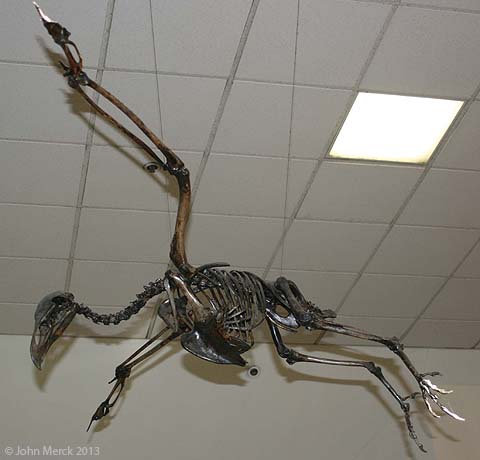 |
| Teratornis merriami credit Ellen. CC2.0 |
Originally I wanted to include more detailed discussions on these two groups in this post but upon seeing how long this post already is I think it will be more practical to dedicate several future posts to both the terratornids and the phorusrhacids respectively. If you paid attention to my last post where I introduced a novel technique among modern flesh rendering birds it should not be too hard to guess what I will infer for both groups. Additionally, in doing so rectify some of the excessively conservative interpretations that have been dominating thought about how these birds fed.
To further embellish my point, that the reason for the bony protuberances, nasal/lacrimal crests and horns in theropods are not just there to make them look wicked but serve a biomechanical outlet for excessive stress, I want to point out that similar features are present in the skulls of other even more distantly related ziphodont predators.
Baurusuchus salgadoensis - the terrestrial croc of late Cretaceous Brazil was sporting some fashionable brow ridges.
_2.jpg/694px-Baurusuchus_salgadoensis_(MPMA)_2.jpg) |
| credit Marco Aurelia Esparz CC3.0 |
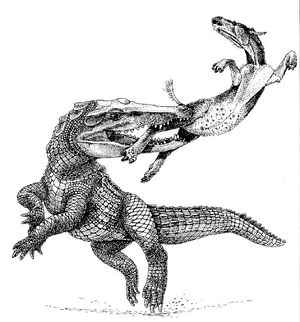 |
| credit Robert Bakker |
 |
| Postosuchus credit Mark Byzewski CC2.0 |
 |
| Batrachotomus kupferzellensis. credit Gedogeheo. CC3.0 |
 |
| Prestosuchus chiniquensis. credit Vince Smith. CC2.0 |
 |
| Perentie (Varanus giganteus) credit Flyingtoaster CC3.0 |
Is it just a coincidence that multiple lineages of Mesozoic theropods, terrestrial ziphodont crocodiles, pseudosuchians, several lineages of extinct/extant carnivorous birds, and monitor lizards all converged on similar headgear designs? I don't think so. This convergence is due to similar solutions to similar mechanical problems incumbent upon ziphodont skulls in both feeding and grappling with large prey items.
.jpg/1280px-Majungasaurus_crenatissimus_(2).jpg) |
| Majungasaurus crenatissimus. credit James St. John. CC2.0 |
Support me on Patreon.
Like antediluvian salad on facebook. Visit my other blog southlandbeaver.blogspot
Watch me on Deviantart @NashD1. Subscribe to my youtube channel Duane Nash.








_1.jpg)
20 comments:
This was yet another great post ^^. I was wondering why most Theropods had some sort of weird heat butting/crest like feature. So what do you think Ceratosaurus used it's crest for? Since it's weirder than the average shock absorbing lacrimal crest, it might have another use. Also, this is kind of random, but isn't Bambiraptor usually considered a juvenile of Saurornitholestes?
Thought provoking, this. Can't wait for your posts on phorusrhacids and teratornithids. Regarding the latter, I've always found their uniqueness remarkable. Why no giant flighted terrestrial birds anywhere else than the Americas, and just South America for most of that time no less. Their evolution might be tied to the weird fauna of the area, but that did not stop them from invading and apparently doing pretty well in North America after the isthmus formed, so they clearly managed in a 'normal' fauna. Why were there no equivalents elsewhere and why did they themselves not spread further? Large, carnivorous birds capable of covering large distances (as we could expect teratornithids to have done, right?) are generally very capable of crossing water and spreading far and wide. Why did teratornithids remain geographically limited? I know I'm going on a tangent here, but do you have any thoughts on this?
Regarding your thoughts, I wonder, are you saying that all this cranial orientation was merely for shock absorption, or do you think it evolved for shock absorption, only to get exapted into ornamentation later? Of course, we do not know what sort of external form these structures took so there might well have been some funky soft tissues going on on those skulls. The lammergeier's 'moustache' comes to mind as do the King Vulture's outrageous ornamentation and the Andes condor's comb. Then, non-avian theropods seem to have been big on hard tissue ornamentation, but then we do not generally know what sort of wattles, combs, tassels, feather crests or colour patterns they may have sported besides those.
As birds with reinforced skulls though, I think adzebills (*Aptornis*) may also be worthy of consideration. Those birds had noggins for some heavy duty stuff. What do you make of them? Here's a skull:
http://nzbirdsonline.org.nz/sites/all/files/1200306S.038212~v%201~Aptornis%20defossor%20skull%20lateral.jpg
This is already a long comment but for modern birds evoking theropods, I see your Lammergeier and raise you Pesquet's Parrot (*Psittrichas*): http://s3.zoochat.com.s3.amazonaws.com/large/img_87481-162260.jpg
Not nearly as large and actually frugivorous, but they certainly look the part.
Great comments, points, and questions.
@Khalil Beiting. I did mention Ceratosaurus a bit in the post, I am of the opinion that when something is a display structure - it is obvious i.e. something large and stands out. The horns of Ceratosaurus would certainly fall in this category.
On Bambiraptor - nice catch, you got me! It was not 'til after I published that I looked more into Bambiraptor and saw that there is a lot of thought it is a juvenile Saurornitholestes. Anything published? I don't know it seems like late Cretaceous North American dromaeosaurids are a bit of a mess anyways. And I still want to see a pic of those giant Alaskan troodons people keep talking about. But my point still stands that small theropods could still have knarly predatory inclinations and we shouldn't always assume that just cuz you are small all you ate was small game. Hint - I will do a post on dromaeosaurids eventually.
@BrianL. Great questions on teratornithids! Could it be that they were actually more widespread in North America but are missing from the fossil record? La Brea might be an exceptional place as it is a predator trap but we are missing them elsewhere because, you know bird skeleton preservation bias? But yeah you are right why could they have not flown up and over into Siberia through Beringia?
On cranial ornamentation. Yes exactly - the impetus was to absorb stresses and strains incurred during feeding and exapted into ornamentation, built in shades, potentially head butting (although I am a bit skeptical on the last one cuz they do seem a bit nippy with all the face biting going on). On soft tissue growing on top of the ornamentation? I think we should see at least some blood vessel openings for such I have not heard of this being documented anywhere.
Nice one on the adzebills. I, probably like many, have heard of them but I kind of dumped 'em in with moas. Guess I was wrong! Looks like they could bite through a substantial branch (or your finger).
That's a beautiful parrot. You probably have heard that falcons are actually close to parrots and their similarity to eagles/hawks etc is convergence.
Thank you for your reply. Note that I did not bring up adzebills for nothing. I get the impression that you are not aware that their habits are rather mysterious but they are generally thought to have been carnivorous or at least omnivorous, and doing something heavy duty. This may have been or included digging up burrowing birds and reptiles and their eggs (I'm reminded of giant petrels and penguins here) or eating carrion. The latter seems, at least as specialisation not particularly feasible since adzebills were flightless and large carcasses were probably thinly spread on the New Zealand landscape. No 'biting branches' here! So, looking at adzebills as theropods and not just birds, we seem to be looking at fairly small, slow, extremely robust hunting theropods with big reinforced skulls and bills. That seems relevant to your post, though most non-avian theropods were probably far faster. Adzebills could probably afford to emphasise strength over speed given said strength and their size in an environment where their food was not fast either and predators of themselves were, especially on the North Island where Haast's Eagle was absent, very few.
As for teratornithids, they apparently were very much landbound despite probably being able to cross seas (and indeed they did, since they did end up in Cuba). Yet, no teratornithids crossing over to Africa or North America before The Great Interchange, it would seem. But perhaps more mysterious is why no other birds like them evolved in the Old World, Australia or North America as far as we know. What did teratornithids do that allowed them and only them to become so large among predatory terrestrial fliers?
great suggestions on the Adzebills I am indeed ignorant to their possibly predatory/omnivorous nature. And ecologically that just makes sense given the paucity of top predators there - just the eagle I know of. An additional rich food resource could have been washed up dead marine mammals and - especially before humans got there - abundant pinniped colonies. When I have the time I will definitely look more into them.
As for the teratornithids not in Africa/Eurasia maybe that space was occupied by large Old World Vultures. One trend I have been noting is that as these birds get larger (griffons, lammergiers, giant petrels, lappet-faced vultures) the boundary between predator/scavenger becomes increasingly blurred.
But again we have the problem of birds in the fossil record bias and admittedly I have not looked into large old world vultures/lammergiers in the Pleistocene. But I would not be at all surprised if they were more diverse and widespread during the megafuana periods.
Are there going to be any future posts dedicated to the hunting and feeding methods of Carcharodontosaurids and Abelisaurids?
@ anonymous Yeah carchs for sure... I don't know when cuz I just kind of go with what is interesting me at the moment. Abelisaurids just frustrate me. Not sure what was going on with them. Esp. Carnotosaurus that massive upper jaw contrasted against relatively slender teeth and lower jaw and heavy neck musculature... Don't know what to make of them?
@Duane Nash
Would Carcharodontosaurs operate much in the same way as Allosaurs with the "bonesaw shimmy"?
And I think that Abelisaurs probably used the sawing method as well, seeing as their teeth were quite small and the jaws quite weak.
Excellent stuff. I read your plesiosaur series and I'm eager to read through this theropod series as it appears. It's all very thought-provoking, especially for doodling and perhaps painting...
Firstlu, I knew about lammergeiers, but I don't think I've ever seen them promoted so well; not even in Attenborough documentaries. Thanks for the eye-opener!
I'm still a bit unsure about a couple of things in the post, though. Looking at lappet faced vulture skulls online, it looks like the supraorbital ridge is based on an eagle-like 'palpebral' (don't know if that term applies to anything other than non-avian dinos), and the whole thing doesn't seem much more chunky and sturdy than, say, a harpy eagle (Harpia harpyja ) skull, especially round that lacrimal area. (A bit chunkier than a golden eagle, though)
I'm surprised to see giant petrels don't appear to have anything there, just highly recessed (though as you say, very thick) frontals; but they still have a supraorbital ridge. Is there some kind of cartilage that doesn't show up in well-prepared online specimens, or...?
In fact the general shape around the petrel orbit doesn't look too different to those of the small nonavians you showed. (Coelophysis etc.) Possibility for a similar supraorbital ridge in those dinosaurs, stretching from lacrimal to postorbital, or are the frontals too weedy compared to the petrel, to support much?
(Also, googling giant petrels brought up a few eyebrow-raising photos, well in line with your previous post. I think I got some more good examples for folks who think feathered theropods can't be frightening...)
Great comment conversation about adzebills too. I don't think I've heard much about them before, but now I can well imagine them patrolling New Zealand beaches,diving into sealion carcasses.
Yes thank you for comments and insightful observations. I am at a loss for good specimens myself to look at first hand and just kind of eyeballing things from pics online.
On vultures/petrels etc etc what I think is going on is that - at this size - they are just starting to show the faintest development of stronger cresting/orbital ridges etc etc. WIth increasing size and increasing vigorous predatory activity I think that they would converge stronger with Mesozoic style headgear. And I think this convergence is shown best in looking at the phorusrhacids and teratornithids. I agree it is strange that life pics of the petrels suggest a bit of eye ridge but when you look at the skull it appears recessed. Maybe there is a band of cartilage there or something. Plus petrels have all that stuff going on with their tube nose which also might be taken up a lot of the stress in vigorous feeding. I also, again just eyeballing from photos online, detect what might be a general thickening/rugosity of skull on the superior part of the skull.
Thanks for commenting and hope you enjoy upcoming posts!!
@anonymous No I don't think carchs would have operated like Allosaurus, can't say anymore saving for future post. As for abelisaurids I don't know they frustrate me. Carnotosaurus in particular.. it would be a good candidate for the bonesaw shimmy but those teeth in the lower jaw just too thin... I have a hard time with the latest interpretation as fast pursuit predator of small/medium game. That neck just seems overdesigned, smh. I don't have a clue to tell you the truth!!
If vultures could use their bills like this, what about Harpagornis? It 's renowned for a vulture-like skull and bill design.
Thanks for comment. Sure it could have converged with new & old world vultures in using choanal grinding. But probably stuck with the hook and pull technique of falcons. eagles. hawks. The superiority in the vulture design is that they do not need to use leverage to get a bite - that means that they can strip meat above their heads or deep inside large carcasses - as opposed to an eagle that must hold down the food with its talons and get above it and pull. Vultures use this technique as well but their ability to move and feed in multiple planes of action makes them superior large carcass renderers. Moas were big - but now elephant big - so Harpagornis probably did fine with hook and pull.
But hey, I never really looked at their skulls and the skull of Harpagornis does look relatively lengthened compared to eagles so maybe you are onto something there...
I will nitpick that Ornitholestes, contra what is said in an off-comment, did not have a nasal horn; that's simply preservation making the snout look like one. This interpretation was corrected a bit over a decade back.
Ooops thanks for catching that. I think I recall that fix now that you mention it.
I just noticed Smilodon has those same thick ridges!!!
Very interesting, good observation Bk Jeong... the supraorbital area in Smilodon does appear a lot thicker than say a lion. I always had problems with Smilodon as a throat killer but felt it more reasonable that they stabbed and slashed the belly region. The forelimbs restraining the prey and - with the mouth closed - the sabres plunging into and stabbing the abdomen. Interesting.
So a full list of carnivorous tetrapods with supraorbital ridges for shock absorbtion, often coubled with serrated dentition and/or papilae on palate and tongue:
-dromaeosaurs (except unenlagiines)
-carnosaurs
-megalosaurs and spinosaurs
-large tyrannosaurs
-phorusracids
-teratorns
-Old World vultures
-New World vultures
-Harpagornis/Hieraetus/Aquila moorei
-Giant petrels
-rauisuchids and other loricatan archosaurs
-sebecids
-pristichampines
-varanids
-machairodonts
What next? Mosasaurs? Nimravids? Gorgonopsids?
We're definitely onto something here...
Add Thylacoleo carnifex and nimravids to the list....they have the same orbitals!!!
Post a Comment